
The Blue Bird Corporation is an American bus manufacturer headquartered in Fort Valley, Georgia. Best known for its production of school buses, the company has also manufactured a wide variety of other bus types, including transit buses, motorhomes, and specialty vehicles such as mobile libraries and mobile police command centers. Currently, Blue Bird concentrates its product lineup on school buses, school pupil activity buses (SPAB) and specialty vehicle derivatives.

A school bus is any type of bus owned, leased, contracted to, or operated by a school or school district. It is regularly used to transport students to and from school or school-related activities, but not including a charter bus or transit bus. Various configurations of school buses are used worldwide; the most iconic examples are the yellow school buses of the United States which are also found in other parts of the world.

Thomas Built Buses, Inc. is an American bus manufacturer. Best known for its production of yellow school buses, Thomas produces other bus designs for a variety of usages. Currently, its production is concentrated on school buses and activity buses, along with their commercial derivatives.

Carpenter Body Works is a defunct American bus manufacturer. Founded in 1918 in Mitchell, Indiana, the company produced a variety of vehicles, with the majority of production consisting of yellow school buses for the United States and Canada.
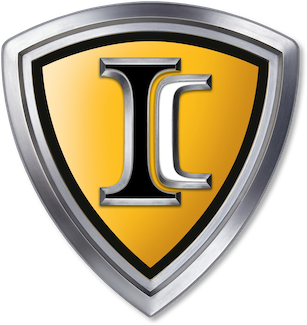
IC Bus is an American bus manufacturer. Headquartered in Lisle, Illinois, IC is a wholly owned subsidiary of Navistar International. Established in 2002 by Navistar through the reorganization of subsidiary manufacturer American Transportation Corporation (AmTran), IC currently produces school buses and commercial-use buses for multiple applications.

Van Hool NV is a Belgian family-owned coachbuilder and manufacturer of buses, coaches, trolleybuses, and trailers.
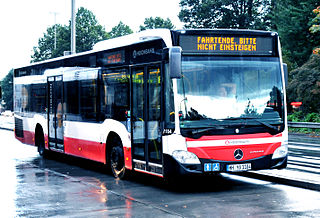
Mercedes-Benz has been producing buses since 1895 in Mannheim in Germany. Since 1995 Mercedes-Benz buses and coaches is a brand of EvoBus GmbH, a wholly owned subsidiary of Daimler Truck.

The Crown Coach Corporation is a defunct American bus manufacturer. Founded in 1904, the company was best known for its Supercoach range of yellow school buses and motorcoaches; the former vehicles were marketed throughout the West Coast of the United States. Competing alongside Gillig Corporation and similar its Gillig Transit Coach, the two companies supplied California with school buses nearly exclusively into the 1980s.

Gillig is an American designer and manufacturer of buses. The company headquarters, along with its manufacturing operations, is located in Livermore, California. By volume, Gillig is the second-largest transit bus manufacturer in North America. As of 2013, Gillig had an approximate 31 percent market share of the combined United States and Canadian heavy-duty transit bus manufacturing industry, based on the number of equivalent unit deliveries.
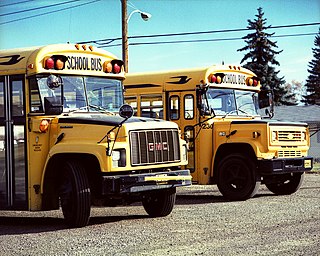
The Chevrolet and GMC B series was a series of cowled chassis that were produced by General Motors. Produced across three generations from 1966 to 2003, the model line was a variant of medium-duty trucks marketed under the Chevrolet and GMC nameplates. Initially derived from the medium-duty C/K series, later examples were derived from the GMT530 architecture.

The Gillig Phantom is a series of buses that was produced by an American manufacturer Gillig Corporation in Hayward, California. The successor to the long-running Gillig Transit Coach model line, the Phantom marked the transition of Gillig from a producer of yellow school buses to that of transit buses. The first transit bus assembled entirely by Gillig, the Phantom was produced exclusively as a high-floor bus.

The Thomas Saf-T-Liner C2 is a cowled-chassis school bus manufactured by bus body manufacturer Thomas Built Buses. Introduced in 2004, the C2 marked the first usage of the Freightliner C2 chassis. While produced largely for school use, the C2 is also produced for multiple applications, including specialty and commercial configurations. The C2 is unique in that it is available in capacities up to 81 passengers, the largest of any type C conventional school bus in current production. It is also the only school bus in North America with the option of a manual transmission.
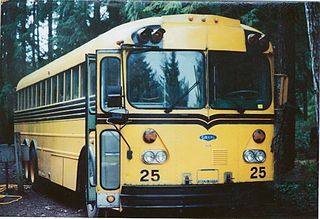
The Gillig Transit Coach School Bus is a series of buses that were produced by the American bus manufacturer Gillig from 1940 to 1982. Alongside its namesake usage as a yellow school bus, the Transit Coach also served as the basis of motorcoaches and other commercial-use vehicles. Marketed primarily to operators on or near the West Coast of the United States, the Transit Coach competed nearly exclusively against the similar Crown Supercoach through much of its production.

The Blue Bird Vision is a school bus that is manufactured and marketed by Blue Bird Corporation in North America and exported worldwide. In production since 2003, the Vision became the first cowled-chassis bus built on a proprietary chassis designed and manufactured by the same company. While it is sold primarily in a school bus configuration, the Blue Bird Vision is also offered with various commercial and specialty seating and design configurations.
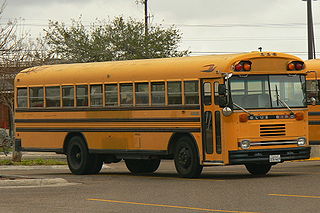
The Blue Bird TC/2000 is a product line of buses that was produced by the American manufacturer Blue Bird Corporation from 1987 to 2003. Introduced as a second transit-style product range alongside the Blue Bird All American, the TC/2000 was produced in front-engine and rear-engine layouts. While produced primarily as a yellow school bus, Blue Bird offered the TC/2000 in commercial configurations and numerous custom-built variants. For commercial use, Blue Bird badged the model line as the TC/2000 or the APC 2000.

The Blue Bird All American is a series of buses produced by American school bus manufacturer Blue Bird Corporation since 1948. Originally developed as a yellow school bus, versions of the All American have been designed for a wide variety of applications, ranging from the Blue Bird Wanderlodge luxury motorhome to buses for law enforcement use.

The ThomasMinotour is a bus body manufactured by Thomas Built Buses since 1980. The smallest vehicle sold by the company, the Minotour is a bus body designed for cutaway van chassis. Primarily sold for school bus usage, the Minotour is also produced as a MFSAB or in specialized configurations specified by the customer.
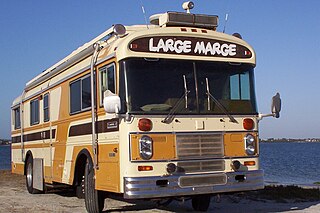
Wanderlodge is a retired series of recreational vehicles built by American bus manufacturer Blue Bird Body Company. Introduced as the Blue Bird Transit Home in 1963, the Wanderlodge was a derivative of the Blue Bird All American school bus for over year; two further generations were produced, adapting motorcoach body and chassis design.
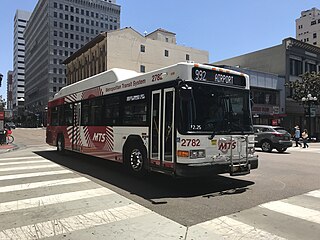
The Gillig Low Floor is a transit bus manufactured by the Gillig Corporation. The second low-floor bus introduced in the United States, the Low Floor has been produced since 1997. Originally produced alongside the Gillig Phantom as an expansion of the transit product range, the Low Floor has become the successor to the Phantom and the sole Gillig bus platform since 2008.

Crown Firecoach is a nameplate used for various types of firefighting apparatus manufactured and marketed by Crown Coach Corporation in Los Angeles, California from 1951 to 1985. Although sold primarily in the West Coast region of the United States, other examples of the Firecoach were sold to fire departments in Hawaii, Illinois, and New Jersey, as well as in Mexico and Kuwait.
























